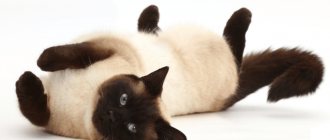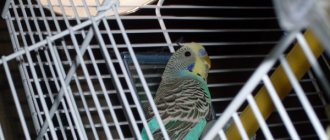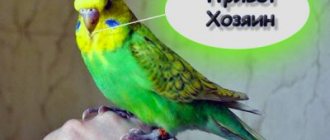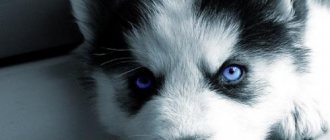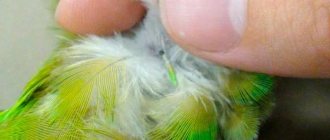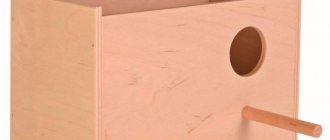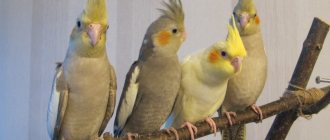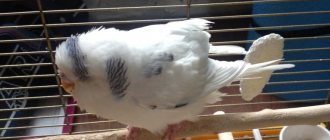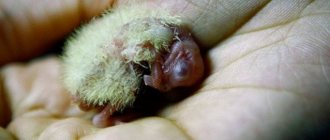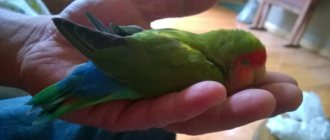There are several main types of budgies, which differ in appearance. Birds are identified by color and type of plumage. The main favorites among budgies are show budgerigars.
Czechs look more massive and majestic than ordinary budgies. Before you go to the pet store for a new friend, it’s worth understanding what differences there are between wavy animals. In this case, it will be much easier not to make a mistake in choosing a specific type of parrot.
Description
This species first appeared in England; one of the owners of the wavy birds had chicks that looked different from their parents. They had a completely different skull structure, the head was several times larger than that of representatives of the genus of budgerigars. Subsequent selection work with parrots allowed breeders to obtain a completely new breed; at the moment it is quite popular among parrot lovers and professional breeders who breed parrots for exhibitions and competitions.
The history of the appearance of the Czech parrot
Hearing the name, you might think that Czech parrots first appeared in the Czech Republic. In fact, birds of this variety were bred in England in the mid-20th century. The breeders enthusiastically accepted the new crested breed and continued their work, crossing blood-related, similar birds. The English Club was founded, in which the best characteristics of show-class birds were consolidated.
In Europe, a special name was found for the Czechs - exhibition parrots, that is, parameters suitable for championships and competitions. There are special standards for them: for example, a large head, a wide forehead, spots on the neck of the same size.
This is interesting! Birds from Eastern Europe were brought into the Soviet Union during the Warsaw Pact through the open border with Czechoslovakia. Including crested budgies, very rare and expensive. The origin of the common noun – Czech – is connected with this.
Appearance
The body length of an adult parrot averages from 22 to 29 centimeters, which is one of the main differences from the wavy parrots. Thanks to active breeding work, you can purchase a parrot of almost any color. The most common colors are yellow, green, grey, lilac, blue and grey. You can also purchase a pet with several colors at once.
Predisposition to disease
Due to the fact that closely related pairs are used to produce purebred parakeets, the parrots cannot boast of health. Bacteria, mites and parasites quickly attach themselves to birds with low immune systems.
To keep your pet healthy, you need to adhere to the following rules:
the cage needs to be cleaned daily;
- disinfect the cage and equipment once a month;
- Before offering to a bird, fruits, vegetables and herbs must be thoroughly washed;
- provide your pet with vitamin and mineral supplements all year round;
- nutrition should be balanced;
- the room temperature should not fall below 18℃;
- do not create stressful situations for your pet (make noise, scare, ignore for a long time);
- Do not place the bird’s home in a draft, under air conditioning, and do not place the cage on a window or on the floor.
New birds brought into the home must undergo a 40-day quarantine.
Spreading
The homeland of wavy fish is Australia. Parrots prefer to live in huge flocks, constantly wandering around the territory in search of food and water. Parrots fly very quickly, thanks to which they can fly vast distances in a short time. They prefer to stop on level places where they eat seeds. This genus of birds is very widespread throughout the continent; moreover, they are analogous to pigeons and sparrows in Europe. For breeding, they choose secluded places on the tops of trees.
Behavior
In addition to external differences, these two parrots differ from each other in their behavior. Budgerigars sing and scream all day long, but Czechs, on the contrary, behave quite calmly and balanced. This feature of Czechs allows them to learn words much faster. These parrots are capable of making fairly long speeches and pronouncing many words very clearly.
Another feature of Czech is that this parrot can calmly wait for its owner in the morning, when an ordinary budgerigar will chirp and sing songs at dawn.
Note! Despite their balance and calmness, Czechs are very sociable and love to talk with their owner and also play with him. Therefore, these pets are often purchased for children.
Czechs are calmer and more balanced than the average budgie.
Show Czechs are considered very tame. This can be explained primarily by the fact that from birth they are under the close control and care of the breeder. From their very birth, these parrots are surrounded by close attention, which undoubtedly affects its condition and attachment to humans.
Behavior and character
Outwardly, Czechs look like real aristocrats and behave exactly the same. They have a calm character, they do not rush around the apartment screaming loudly. With all their appearance, Czechs show their beauty and importance. Most owners note the Czechs' penchant for communication, attention from the owner and love for games. Thanks to their extraordinary intelligence, they can remember human speech. With proper training, they can learn to carry out simple commands, assemble small pyramids and carry objects.
For a parrot to memorize human speech, you do not need to specifically train them.
Some birds independently reproduced sounds they had heard earlier. To train your pet, you should train it daily. Any birds are not the most patient students, so 15 minute lessons will be enough for them to start with, then they can be extended to 40 minutes.
A talking bird is the pride of its owner
As mentioned, show type budgies are more successful in learning to repeat human speech. Males are especially successful in this matter, but females are also good at learning to speak.
In order for the training to be successful, it is necessary to ensure that the future “talker” has daily communication (if possible, only with people, and not with other parrots, if there are any nearby).
Irresistible appearance, cheerful disposition, good learning ability, the opportunity to participate in exhibitions are enough reasons for a bird that loves people to soon become a new member of your family. Watch a video about exhibition budgerigars. So, Czechs.
Differences from wavy
Czechs are bred from budgerigars, however, they differ quite significantly from their ancestors. The main differences are as follows:
- The size of Czechs is at least one and a half times larger than their relative.
- There are feather caps on the head.
- There are spots of different colors on the chest. Their size is larger than that of budgerigars.
- This breed is less active than the Wavys. They prefer a calm, unhurried gait to running; they can fly for a short time.
- On average, they have a calmer character. There are particularly active individuals that delight the owner with their squealing and active behavior.
- The bird's wings lie on the sides, and do not intersect on the back.
- One of the biggest differences is the cost of the chick. For professional breeders, the price quite often crosses the 10,000 ruble mark. In nurseries the price may be even higher, but such a bird will be able to take part in exhibitions.
Other budgies
Single color
This breed of “wavy birds” has a certain feature - only one color dominates in the color of the birds. For example, green, yellow, white, blue. If the predominant color is green or blue, then the bird has the usual waviness, if yellow or white, then the bird has a pale waviness. Ash gray (anthracite) parrots have black wavy, while pure white (albino) parrots have none at all.
Multicolor
Such parrots are also called rainbow parrots, because this breed has different colors in its color, almost evenly distributed throughout the body of the bird. This species has its own varieties:
- variegated - a range of up to six different colors is distributed in a chaotic manner throughout the parrot’s body;
- harlequins - different colors in the area of the belly and chest of the bird have a clearly noticeable boundary;
- penguins - the upper part of the body is painted one color, the lower part another.
Spangles
The name of the parrot breed comes from the English spangle, which means “bugle bead” in Russian. Birds of this species have an inverted, mirror-like waviness.
Curly (Feather Dusters)
The budgerigar breed, bred in Japan, is similar in appearance to the Parisian trumpeter canaries. These birds acquired their name because their body is completely or partially covered with a large mass of long curly plumage. Because these parrots never stop growing feathers, they have lost their aerodynamic properties and cannot fly.
Content
The difference between the content of wavy and Czechs is small. The second ones are a little more unpretentious. The basic requirements for birds are as follows:
- The room should have a comfortable temperature above 20 degrees Celsius.
- The length of daylight hours should be from 10 to 13 hours.
- Certain conditions for air humidity.
- Constant communication with the owner. If this is not possible, it is better to get several birds that will communicate with each other.
Cell
The size of a suitable cage for a bird is 30*40*50 cm. This space is quite enough for one Czech; for several pets it is better to increase the size by 2-3 times. The best option for a family of parrots is an aviary. Inside you need to put several toys, a house for nesting (reproduction), drinking bowls, perches and feeders.
Czechs are a breed that was developed after crossing relatives' birds, which is why the birds' health is quite poor. The immune system has difficulty coping with even the simplest diseases. To protect your pet from diseases, the cage must be cleaned daily, morning and evening. 2-3 times a week it is necessary to disinfect drinking bowls and feeders.
Nutrition
It is better to place several feeders in the cage, each of which will contain different food. Grain is usually poured into one, mineral fertilizer into the other, and vegetables and fruits into the third. They can also be hung on the cage using holders.
The majority of the diet should be grains. Birds love millet most of all; in addition, you can add flax, oats and wheat. In general, one teaspoon of grains per day is sufficient. You can also supplement your diet with herbs, cottage cheese, boiled eggs, cereals and vitamins.
Care
All that Czechs require is proper care and constant contact with the owner or other birds. The first most important condition is the air temperature in the room. Parrots feel comfortable at temperatures from 20 to 25 degrees Celsius. Temperatures below 18 degrees are already critical for birds; the time of year is not important. It is also important to ensure that there are no drafts in the room.
The length of daylight hours is very important for Czechs, since in captivity they spend a lot of time in the sun. Moreover, the duration directly depends on the season of the year. In summer, the required duration is about 15 hours, in cold months - up to 10. The best option is, if possible, to take the cage outside (at a fairly warm temperature of hot air) for the whole day.
It is better to install an artificial color source indoors; a pet store can suggest a suitable lamp; you can also contact the breeder from whom you purchased the pet.
It is also necessary to perform a number of bird care procedures, including the following:
- Cleaning the cage or enclosure in which the bird lives. This must be done twice a day, morning and evening.
- The water in the drinking bowl must be changed every day; the parrot will not drink slightly stagnant liquid.
- It is also necessary to change the food in the feeders daily - constantly add fresh grain or mineral supplements, as well as change fruits and vegetables.
- The parrot must also be allowed to walk around the premises. A short flight walk once a day is enough.
- Parrots wash themselves enough; a bath day can be arranged once a week.
How to choose and how much does it cost?
Such expensive birds should be purchased at pet stores or from trusted breeders. Buying from a random seller can bring a lot of problems. It may turn out that this is a half-crested parrot, which cannot be shown at an exhibition.
When choosing, you need to watch the parrot for at least half an hour. He must actively respond to attention to himself. Nobody expects the Czech to mindlessly rush around the cage. Despite its calm nature, the bird should look well-groomed and examine everything around with curiosity. The feathers are smooth, the eyes are shiny.
If the bird is lethargic and depressed and does not move from its position on the perch, despite external stimuli, this should alert you. There should be no delamination or growths on the beak. The claws should be fine. If there is at least one small bare area in the plumage, it means that the bird’s health is not in order.
A Czech child between 3 and 5 months old gets used to a new situation better. Males are more easily trained, although girls will also talk if you show persistence and patience.
The price for a Czech parrot is higher than for an ordinary wavy. The price range is wide and depends on the age, place of purchase and condition of the chick: from 1000 to 3000 rubles per individual.
You need to be prepared for the fact that after moving to a new place, the parrot will experience stress and refuse to eat, be sad and inactive for a week. There is no need to disturb the bird, but give it the opportunity to get used to the new environment and handle it with care.
Diseases
Due to the poor health of the birds, Czechs quite often suffer from mycosis or dysbacteriosis. There are also parasites or worms, as well as viral or bacterial diseases.
Not a single bird is protected from illnesses, despite proper care and maintenance.
When the first signs of disease appear, you should immediately go to the veterinarian. It is strongly not recommended to treat your pet yourself; in the end, you can only make the parrot worse. It is necessary to carry out the following procedures daily to ensure that the bird is always healthy:
- Clean the parrot's place of residence.
- Closely monitor the health, activity and plumage of your pet.
- Place only fresh and clean vegetables and fruits in the feeder.
- Add mineral and vitamin supplements to food.
Diseases and their treatment
Numerous inbreedings during the breeding process affected the health of Czech parrots. They often suffer from colds. Weak immunity makes these birds vulnerable to:
- ectoparasites;
- worms;
- mycoses;
- dysbacteriosis.
And, of course, they are more susceptible to bacterial and viral infections.
It is extremely important to implement proper preventive measures in a timely manner. Keep the bird clean and regularly inspect the plumage for insects. Individuals prone to digestive disorders can be given probiotics.
If your pet is sick, it should be immediately shown to an ornithologist. Do not self-medicate, because it is very easy for a non-specialist to make a mistake with the dosage of drugs, which can harm the parrot.
Price
The main difference between wavy fish and their descendants is the possibility of acquisition and cost. The former can be purchased at any pet store, and the latter only in specialized nurseries or from professional breeders. It is very important to purchase a pet on whose leg there is the age of the bird, a specific number and information about the place of purchase.
The ring guarantees the owner that his pet was bred by professionals, she is young and will live next to her owner for many happy years. Without it, it will not be possible to form a pedigree and, as a result, perform at exhibitions. In addition, such parrots have many times fewer offspring than unbanded birds. For this reason, and also because of the small number of chicks born, the cost of a young individual can reach 20,000 rubles.
How to buy a miracle pet
Top breeders
If an ordinary wavy can be easily bought at a pet store or even at a bird market, then with the Czech parrot everything is somewhat more complicated. Aristocratic birds of pure blood can only be purchased from a breeder registered in a Russian club. Half-Czech dogs are widespread in our country and are often passed off as purebreds.
Since breeding of exhibition budgerigars began relatively recently in the history of Russia, more noble birds are easier to find abroad.
Who is better to buy a parrot from?
When choosing a little friend, you need to pay attention to the presence of a non-removable ring and documents. Only a chick that has left the house at the age of 40-50 days is considered ideal for purchase. He has not yet had time to settle down in the pack, so we are teaching him more conversation. If the baby was hand-fed, you will get an affectionate, sociable pet.
When purchasing, carefully inspect the individual. She must have all the flight feathers in place, as well as the tail feathers. You cannot listen to scammers who claim that the chick is simply small or molting. There is a risk of purchasing an old, sick parrot. The look of a healthy wavy is clear, the plumage is clean. Inspect the cloaca area especially carefully: the feathers should not be stuck together or stained with droppings.
The purebred feathered friend meets the breed standard, and its color corresponds to the declared color variation. However, the characteristics of this species are fully formed by four months; at an early age, the Czech can be confused with an ordinary budgie.
It is worth taking a parrot from a breeder
Fixed ring and cost
Due to low fertility and difficulties in breeding, such a bird cannot be cheap. A hand-fed Czech parrot registered in a Russian club costs from 5,000 rubles. Depending on the breed, color, fluffiness and pedigree, the price of a bird can reach 15,000. A ringed individual, but raised in a nest, can be purchased for 3,000 rubles. Cheaper little ones are sold without documents and a permanent ring, which makes it impossible to determine their age and blood purity.
To obtain a pedigree and participate in exhibitions in the future, the owner puts special permanent rings on his wards. The color of this item corresponds to the year the parrot was born. Additionally, it contains the unique number of the breeder, the serial number of the chick, and club data. Igor Ignatenkov
Conditions of detention
To avoid mistakes and make your pet’s life in captivity as long and comfortable as possible, you need to learn a few basic rules.
Conditions for keeping a parrot at home
Conditions of detention
Regardless of what kind of parrot you decide to buy, it definitely needs a cage. Since Czechs are larger in size, he will need a spacious cage. It is not recommended to keep a parrot in a cage all the time, even no matter what size the cage is, since it, just like a person, necessarily needs movement. This is necessary so that he can stretch his muscles.
If you have pets such as cats in your home, then it is best not to purchase a parrot at all.
Among other things, when keeping a Czech it is worth considering the following subtleties:
- The cage of these pets, regardless of whether it is a Czech or an ordinary budgie, should be kept in order. This requires cleaning it daily.
- Regardless of what kind of parrot you keep, water and food should be changed daily.
- Exhibition Czechs are big fans of chewing on something, so you should purchase a special stand to accommodate them. Budgerigars do not require a stand.

